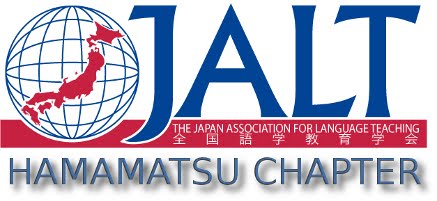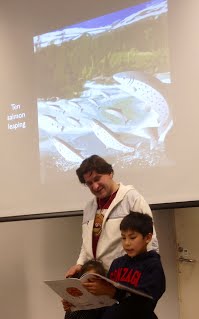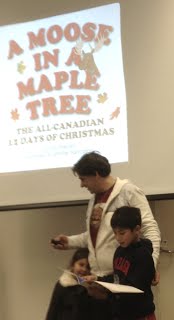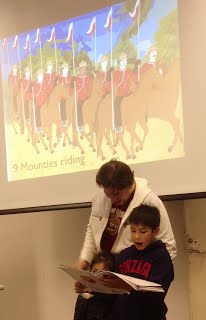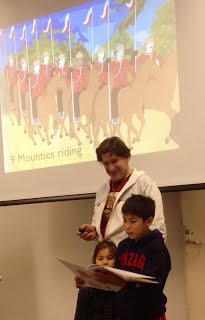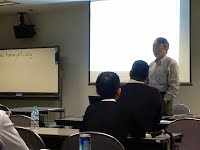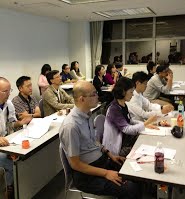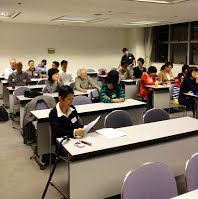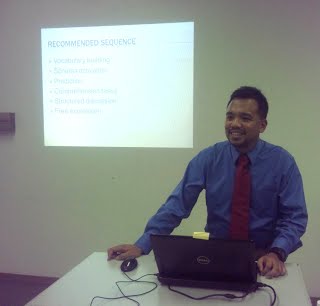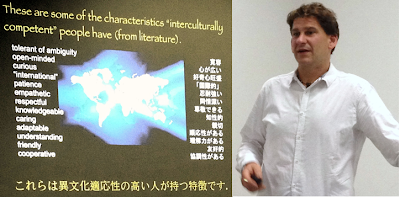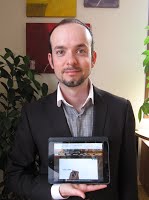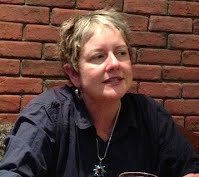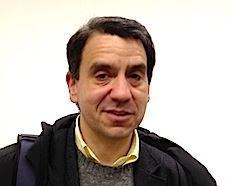2014 Meeting Minutes
December 13, 2014 Hamamatsu JALT's annual "My Share" and year-end party
On December 13, Hamamatsu had its annual My Share presentations and year-end get together. Gregg McNabb led off with a Canadian version of "The 12 Days of Christmas" to demonstrate how learners can use Quizlet and Moodle's quiz plug-in to do review or self-study (in this case listening and vocabulary). Next, Sue Sullivan shared with us in some detail how she has flipped classrooms by having student-led lessons to empower them -- interesting stuff! Then lively Abbi Spencer told us what we already knew, use YouTube. Or at least this is what we were thinking until she exposed us to a variety of informative and extremely well-designed short videos, such as the effects of caffeine on our system. Awesome! Batting clean-up, Jon Dujmovich brought his children in to perform a heartwarming Canadian version of "The 12 Days of Christmas." Toward the end we were really believing it was "10 salmon leaping, 9 Mounties riding...5 ho-ckey sticks...." Turning more serious, Jane Joritz-Nakagawa was ready to deliver an entire lecture on gender-balanced poetry armed with her copious and detailed handouts. We learned that there are indeed many accessible and appropriate poems we can introduce into our classes, so some of us (this reporter is one) should try to do that more often. Then, Adam Jenkins also talked about the flipped classroom from several perspectives, but mentioned something that we tend to overlook, which is that we need not flip an entire lesson (we often think in whole-lesson blocks), just 15 minutes is enough or for as long as seems appropriate. From consideration about which poems to use to an actual poetry recital, Dan Frost (no relation) recited three seasonal classics from memory: Poetry "The Road not Taken" by Robert Frost, the first and last section of Walt Whitman's "Song of the Open Road" and "Stopping by Woods on a Snowy Evening" also by Robert Frost. Nicely done, Dan! Finally, Serena Samsel wrapped up the evening with a brief demo lesson to encourage beginning speakers to become more active. Secretly, some of the advanced-level participants may have been speaking out of turn, which the presenter graciously allowed to go unpunished. |
October 25, 2014: The Why and How of Using E-learning Systems / なぜ/どのように eラーニングで学ぶか (Gregg McNabb & Adam Jenkins)
Regrettably just 5 or 6 people attended this presentation about why and how to introduce e-learning into mainstream classrooms. Quite possibly, this is indicative of the state of the art. The purpose of the workshop style presentation was to show that becoming
proficient in e-learning systems is simple and explain how it contributes to teachers' best practices as regards pedagogy. The basics of Moodle, the
current world standard in learning management systems, were demonstrated. Adam Jenkins explained that e-learning and blended learning will soon be facts of life and that MEXT has already decided that e-learning will be part of teachers' futures. He explained numerous reasons why using a learning management system (LMS) is sound pedagogy. Primarily, it allows teachers to focus on aspects of active learning and collaborative learning. He explained how using an LMS effectively can save hours and hours of work, especially when collaborating with other educators. Gregg McNabb explained in simple terms how to use the LMS, feature by feature, often with "passionate interludes" when several participants were skeptical about the relative merits of an LMS. Specifically, he intoned that as LMSs will become a de facto part of educaton in Japan for 5 core subjects within the next five years, teachers need to familiarise themselves with new technologies. *All detailed explanations about using Moodle are still available in Japanese or English from either of the presenters and both also have Japanese language presentations available that explain important rationales for adopting a nationwide standard. Reported by Gregg McNabb Gregg McNabb 静岡理工科大学准教授。 日本在住20年以上。過去に中学校、高等学校の教員も経験。文部科学省認定教科書シリーズ(英語)の編纂経験もあり、多くの英語教育教材を発行。 京都教育大学では英語教員に対して教育のレクチャーを実施。 過去には週末に採点業務に追われていたが、現在は採点には全く時間をかけていない。 Adam Jenkins 静岡理工科大学教育開発センター講師。 日本在住10年。静岡理工科大学の教育改革に携わる。教員に対し、コンピューターやeラーニングは全く怖くないことを啓発したい。 McNabb同様、テストの採点には時間を全くかけない。 |
September 20, 2014: A Discussion and Debate on English Education in Japan (Kensaku Yoshida and Dan Frost)
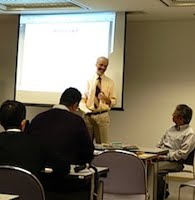 On September 20 Professor Kensaku Yoshida and Dan Frost discussed the question of how much English can be used to teach English in Japanese primary and secondary schools to a packed room of JTEs, ALTs, JALT members, and other interested parties. Dr. Yoshida argued that it is possible to use English only in beginning level classes, from primary through to the first year or so of junior high school, but as language becomes more abstract, scaffolding in Japanese becomes necessary. He offered several examples. Mr. Frost countered by stating that even if true, the textbooks used by primary and first year junior high school students are heavily dependent on Japanese from the beginning. Moreover, first year junior high textbooks start introducing grammatical terms in Japanese, suggesting that there is a set policy to teach English by using Japanese, rather than English. Dr. Yoshida further argued for the sensible use of Japanese in the classroom, especially when explanations if given in English would risk overshadowing the objective of a task; and for developing English as the lingua franca so that students can express themselves in English in their own way rather than adhering to a native speaker ideal. Mr. Frost said that Dr. Yoshida’s view sounded reasonable, but that having an open-ended policy of using Japanese whenever it seemed necessary might well inhibit the full use of English, leaving learners ultimately dependent on their L1. Dr. Yoshida was on the Central Education Committee responsible for creating the Course of Study 2009. Its aims, in theory, have been implemented in Japanese high schools as of 2013. *As an afterthought, it was interesting to learn that only two people out of the 50+ (mostly JTEs) had read the Course of Study for English, which, as Dr. Yoshida pointedly stressed, encourages teachers to use modern pedagogy and methodology and does not constrain, as some believe. Reported by Dan Frost and Sue Sullivan / *Afterthought: Gregg McNabb |
Sunday July 13, 2014: Integration of critical thinking in EFL education by Roehl Sybing
Roehl Sybing’s interactive presentation had all attending Hamamatsu JALT members donning their critical thinking caps. After giving a brief rundown of the evolution of critical thinking (CT) across the centuries, Roehl explained why many hold it as one of the more desirable skills of not only speaking a foreign language, but within one’s own language. Inside the EFL field, being able to reflect and engage critically can demonstrate a genuine utilization of language, among other things. However, Roehl holds that the facilitation of CT in EFL must precede discussion of issues, and if there is not enough scaffolding, demotivation can occur because appropriate levels of language needed for comprehensive input and output have not been met. Therefore, he suggests a sequence when integrating CT in the EFL curriculum: 1. Vocabulary building, 2. Schema activation, 3. Prediction, 4. Comprehension tasks, 5. Structured discussion and 6. Free expression. These stages are linked to Bloom’s Taxonomy of learning. CT is the ultimate goal. Roehl led us through a series of exercises which reflected these stages, and resulted in a lively discussion amongst groups about issues raised. The exercises were useful models for further CT adaptation and exploration in our own classrooms.
Reported by Susan Laura Sullivan. |
June 14, 2014: "English Activities for Intercultural Awareness" by Jon Dujmovich
Jon Dujmovich (Aichi University, Imagination Ink) has a long history in designing and implementing English activities and courses focusing on intercultural communications. On June 14 he introduced members to basic intercultural developmental concepts. We then participated in a series of activities created to encourage students to question their role within three spheres of culture: inherited (universal and human nature), learned (specific to a group or category) and inherited and learned (specific to the individual, personality). At a lower level, Jon demonstrated exercises that could be used with younger students to nurture curiosity and awareness of cultural diversity, such as taking note of the wide range of English that exists in their daily life. It was a lively, thoroughly engaging and informative session, providing participants with practical and appealing resources for classroom use. Reported by Susan Sullivan |
May 17, 2014: "How to Build a Mobile-Friendly Interactive Website" by Renaud Davies
Renaud Davies (Hiroshima Bunkyo Women's University) feels that the more engrossed students are in a task and content, the more likely second or foreign language acquisition is to occur. There are many tools available online to enhance the interaction of language learners with other learners, their teachers, their own community and the global community. Having all these tools in one place where both students and educators can access them can expand the experience of learning and using another language. Davies led an interactive workshop whereby he guided members in creating their own website through the free Wix webpage. Wix has a series of features which teachers and students can access, implement and adapt to create non-static homepages. The ensuing engagement with both the content and technology selected can result in increased learner autonomy, linguistic authenticity and an intrinsic motivation to use English or the language of instruction. Reported by Susan Laura Sullivan |
Sunday April 13, 2014: "Surrealists in the classroom" by Susan Sullivan
On April 13 Sue Sullivan gave an interesting and well-planned presentation cum workshop in which she showed us how to introduce and integrate elements of Futurism, Dadaism, Cubism and/or Surrealism into the general young adult EFL classroom. She has had success having her university students interpret poetry, especially, by interacting with their classmates. Students in her classes have used all four macro-skills and made creative visual mini-projects for review and discussion by other students. From this writer's perspective, perhaps the most important linguistic value of Sullivan's introductions and explorations of these artistic and literary movements is the copious amount of students' negotiation of meaning that takes place when they try to apply what they've learned and then accurately explain their projects to numerous classmates. Students are required to expend quite a bit of effort so that others can grasp their intended meaning. The explorations of the history and circumstances of these pivotal movements would probably appeal to most curious students. The elements of her course as presented would likely be very well received in a general elective course, but might meet with resistance in more narrowly focused programs. Reported by Gregg McNabb |
March 9, 2014: "Developing Fluency and Communication Skills through Discussion and Debate" by Daniel Warchulsky
In his presentation, Daniel Warchulsky ................ |
February 8, 2014: Job Information: Academic work in Japan by Richard Miller
On Saturday February 8, 2014 Richard Miller gave a nonstop, comprehensive presentation about the requirements of a good academic curriculum vitae and what universities are requiring from candidates. His presentation was mainly aimed at junior lecturers, but there was also valuable information for more seasoned educators. According to Prof. Miller, approximately 68% of employers in Japan request a specific academic c.v. and the qualifications for work in the academic world in Japan (particularly for English) are becoming more and more rigorous. Therefore a carefully designed academic c.v. is essential. On many occasions he stressed the paramount importance of not only publishing, but also working to have a full, balanced c.v. According to Miller, a balanced c.v. attends to research, teaching and service. He suggested that we need to regularly consider how balanced we are, for example by using a score card style evaluation, such as is used in the business world. He emphasized personal branding and building an Internet presence by registering at Academia.edu and Linked In, so that if potential employers do an Internet search, our names will appear. He recommended we keep very detailed files not only of presentations and publications, but also of classes taught, including class size. The reason for such scrupulous attention to detail, he said, was to differentiate ourselves and thus gain some edge over less detail-oriented applicants. He stressed that we have to look very good on paper. In conclusion, it was clear from Prof. Miller's presentation that maintaining a proper academic c.v. involves considerably more effort than basic updating every year or two. Reported by Gregg McNabb |
January 19, 2014: Using a cross-curricular approach in children's English classes by Lesley Ito
Using a cross-curricular approach in children's English
classes, by Lesley Ito. The presenter emphasized the importance of teaching language in a meaningful context, that is interesting to children. For example volcanoes can be used to teach numbers with their height and the years in which they erupted. Or how to make a mummy can be a theme which teaches verbs such as "take out", "dry out", "stuff", and "wrap." Or colors can be reviewed using white coffee filters, on which a line of color can be drawn with water-soluble ink, such as orange, and then dipped into warm water, after which it bleeds into shades of its original primary colors. Lesley also stressed that the level of language needs to be appropriate for the learners, and that teachers need to scaffold lessons with English expressions that are needed for each activity, so that children don't just get excited about the topic and revert to using L1 most of the time. She showed us several other ideas, such as how using cups made of different materials (glass, metal, plastic, ceramics) will conduct the temperatures of liquids put in them to different degrees. Then children can touch the outsides of the cups and make comparisons: the metal cup is hotter than the plastic cup, for example. Or doing a lesson about famous people and using that to practice questions: Where - from? What - do? Her overall point was that language should be contextualized and supported in ways that children will both enjoy learning and remembering. We found her ideas both refreshing and useful. |
